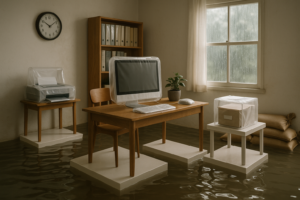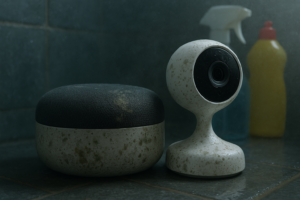Remote work is now a regular part of life. As a result, home offices have become more than just a corner with a desk, they’re a critical hub for productivity, creativity, and livelihood. But many do not realize that these dedicated spaces have unique risks. Water damage and mold growth can quickly jeopardize your productivity and health. Electronics, paper files, and furniture in your workspace are all at risk. This article brings attention to these hidden dangers, the specific sources in remote workspaces, and walks through how you can enjoy a safe, dry, and productive environment at home. Learn how to spot early signs and protect your work sanctuary.
Why Home Offices Face Unique Water and Mold Risks
With remote work on the rise, homes double as offices for millions. This rapid shift has introduced challenges that traditional workspaces rarely encounter. Unlike commercial offices, home workspaces are often shoehorned into rooms without commercial-grade construction, moisture control, or building maintenance.
Paper records, electronics, and plush chairs replaced file cabinets and utility furniture. High-tech computers and charging stations hum away in converted bedrooms or spare nooks. Extended hours mean these spaces are used for longer periods, raising the stakes for even minor water issues.
Leaky plumbing, an unnoticed roof drip, or poor humidity control can disrupt your productivity. Mold begins to grow remarkably fast, sometimes just a day or two after exposure. In homes that close doors for privacy or do not circulate air well, moisture can get trapped. Your investment in computer equipment, reference materials, and well-designed lighting can deteriorate if moisture sneaks in.
Unlike a flooded basement or sewer overflow, these costly incidents can seem small. Yet they lead to persistent odors, ruined photographs or files, deteriorated drywall, and in some cases, persistent health complaints. Understanding how modern home workspaces work helps you stay ahead of the problem.
How Water and Mold Threaten Your Remote Workspace
Water is a constant foe, even if you cannot see it. Desks, chairs, electronics, and stacks of paperwork all absorb moisture. A tipped-over water glass, a slow pipe leak, or even humid air over time does damage.
Mold spores are everywhere in the air. When they land on a wet or damp surface like drywall, fabric, carpet, or stacked files, growth starts rapidly. By the time you notice fuzzy patches on the wall, spores may have spread inside the wall or hidden under carpets. Mold’s most common trick is its invisibility. It hides behind furniture, under rugs, within air conditioning vents, and deep inside cracks.
Damage sneaks up. You might spot peeling paint, a faint musty odor, or slight discoloration. Electronics affected by humidity or drips may start to glitch. If your phone charger suddenly stops working or a laptop overheats, subtle moisture might be the cause. Allergies and respiratory symptoms worsen in the same space where you spend forty or more hours per week.
Even a small amount of moisture can permeate walls, ceilings, or floors, making recovery more complex. Without catching it early, what seemed like a minor inconvenience balloon into a bigger health hazard.
Main Sources of Moisture in Home Offices
Every workspace presents its own set of risks. Understanding where moisture comes from keeps your space protected.
Plumbing failures remain a common culprit. Even slow leaks from pipes within the wall go unnoticed for weeks. Drywall or carpeting absorbs drips, while the silence and warmth encourage hidden mold colonies.
Roof damage brings trouble, too. A missing shingle or old flashing lets rain in. Water finds the easiest path, often inside exterior walls, along ceiling joints, and directly above your workspace. Stains may appear overhead, or you might see bubbling in the wall paint.
Modern homes are built for energy savings, which often means windows and walls are sealed tightly. Without airflow, humidity accumulates. If your workspace lacks regular fresh air, the room turns into an ideal spot for condensation. Simple differences in temperature inside and outside the walls or windows cause moisture beads to form. Over time, trapped moisture leads to black spots on the windowsills or greenish patches where the furniture touches the wall.
Even household chores bring risks. If dryers vent into crawlspaces or bathrooms fail to exhaust air outdoors, residual steam lingers. Materials stored in closets or file organizers in these spaces stay damp.
Recognizing Early Signs of Mold and Water Issues
Often, the earliest symptoms are subtle. By tuning your senses, you spot trouble before widespread harm occurs.
A persistent musty odor in your workspace, especially when you return after time away, signals hidden moisture. This smell comes from both standing water and mold colonies feeding on wood, fabric, and paper. If the odor persists after basic cleaning, look deeper.
Peeling or bubbling paint reveals moisture trapped behind the walls. Walls or ceilings peeling away at the corners or along trim signal that water has collected. In more advanced cases, you might spot stains, yellow, brown, or even grayish patches that suggest ongoing leaks overhead.
Furniture legs, especially those placed near windows or outside walls, can display dark stains or soft spots. Check around power strips, behind computers, or inside file cabinets. Carpets often hide dampness close to the wall or beneath heavy objects.
Visibly fuzzy patches in green, white, or black signal mold. These can crop up in less-visited corners, behind bookshelves, or anywhere airflow is weak.
Unexplained coughing or sneezing in your workspace, not present elsewhere in the home, might point to airborne spores or dampness. Health effects, especially if they align with long hours spent in the office, help pinpoint the problem room.
Preventing Water Damage and Mold in Remote Workspaces
Proactive steps make all the difference. A little vigilance reduces risk for everyone working from home.
Controlling indoor humidity is your first line of defense. Aim for a range of between thirty and fifty percent. When the air feels sticky or you notice condensation, a quality dehumidifier can make a big impact. During hot or rainy months, check humidity with an inexpensive meter.
Proper ventilation is essential. Use exhaust fans in nearby bathrooms or kitchens, always venting air outside. Open doors and windows regularly to boost airflow, which interrupts mold-friendly conditions. Air conditioning units, in good working condition, further prevent moisture buildup.
Watch for leaks or signs of water intrusion. Address spills, snapped pipes, or rain-induced wet spots right away. The faster you dry or remove wet material, the less chance mold has to take hold. Quickly drying affected papers, pulling furniture away from wet walls, and using a fan can minimize permanent damage.
Regular maintenance prevents future headaches. Clean gutters prevent water from running down outside walls into your office space. Make sure water flows away from the building, the ground should slope outwards. Routine inspections, especially after rainstorms, help spot issues before they get bigger.
Condensation deserves close attention. If you spot moisture collecting on window panes, pipe surfaces, or glass table tops, this is often a sign of humidity imbalance. Wipe away water droplets quickly. Consider insulation for pipes in colder rooms or weather-stripping for windows.
Pay special attention after building renovations or changes. Moving walls or adding outlets sometimes disturbs hidden pipes or creates new condensation points. After any upgrade, watch the space closely for new stains or moisture.
How Electronics and Office Materials Worsen Damage
A home office brims with devices not often found in living spaces. Computers, printers, routers, modems, and backup drives all require power and delicate wiring. Most sit close together to maximize workspace or under desks to keep cords hidden. Unfortunately, this tight arrangement creates places where water lingers unseen.
Dripping water or high humidity can corrode metal connections or leave condensation inside power strips. Shorts or sparks may result. Many surge protectors and chargers hide between desks, chairs, or behind drapes, far out of regular sight. Mold loves these dark, warm, and snug spaces.
Printers and fax machines often stay powered on, creating warmth that attracts moisture and fosters growth in hidden crevices. Important documents, especially if stacked close to the floor, can wick up moisture from damp carpets.
Books, paper files, and framed certificates soak up humidity. Fabric desk chairs, footrests, and upholstered seating trap moisture deep within, sometimes leading to mold colonies that are difficult to remove, even after a deep clean.
The cost of lost equipment or paperwork can be immense. Replacing electronics costs time and expense. Data loss can mean lost contracts, contacts, and priorities. For those working with sensitive client data or unique creative content, this risk runs even deeper.
Best Tools and Supplies for Moisture Control
Modern solutions give you the upper hand. Equipping your workspace with the right tools preserves your hard work.
A digital hygrometer instantly reads the humidity in your home office. Check this gauge often, especially during rainy or humid seasons. When the percentage climbs outside the safe zone, run a dehumidifier or the air conditioner until moisture returns to normal.
Good-quality air purifiers, especially those with HEPA filters and moisture-reducing features, help trap airborne spores before they settle. Place air purifiers where airflow is weakest or in corners where drafts do not reach.
Smart leak detectors now alert you instantly through your phone if water is detected under a sink, behind an appliance, or on the floor. Position these sensors wherever plumbing is nearby, such as under a desk with a radiator or by the office wet bar.
Maintain a backup supply of absorbent towels, portable fans, and silica gel packs. These supplies allow for quick intervention after a spill or leak.
Use water barriers or waterproof mats beneath electronics. Racks or shelving keep papers and cords elevated. When reorganizing, avoid placing any furniture directly against exterior walls.
Consider window insulation film or thermal curtains during cooler months. This reduces window condensation and keeps the workspace comfortable.
When to Call a Professional for Water or Mold Issues
Spotting the early signs is only half the battle. Some incidents require expert attention before they grow worse.
Large or recurring water spots on ceilings, sagging drywall, and strong odors anywhere in the workspace signal serious issues behind the scenes. Mold spreading beyond a small, isolated spot means airborne spores are likely everywhere.
If you have health symptoms that match time spent in the office, such as coughing, wheezing, headaches, or itchy eyes, seek outside help. When you discover large patches of mold, unexplained electrical failures, or areas that remain damp even after cleaning, do not try to address it alone.
Consult a team that specializes in water damage and mold control. At All Nation Restoration, we help find the source, correct the issue, and restore your equipment and furniture to usable condition. Acting quickly prolongs the life of your workspace and breathes new life into its air quality.
Visit All Nation Restoration to learn more or call immediately for an assessment. Protect your investment, productivity, and health by getting expert support.
Prioritize a Healthier, Safer Home Office
Safeguarding your workspace begins with awareness. understanding water damage starts with recognizing that no space is too small or too new to have hidden risks. Mold hides under equipment or creeps into walls, making it a common issue in remote working. The mix of humidity, poor ventilation, and the unique demands of electronics means vigilance pays off.
Monitor humidity, fix leaks promptly, and keep electronics dry by placing them away from known trouble spots. Listen to what your nose and your devices tell you; unusual smells or recurring tech issues often signal a need for immediate action. Regular cleaning supports airflow and makes early detection easier. Thoughtful layout and strategic use of modern tools further minimize risk.
If you notice signs of water damage or mold, bring in experts before problems escalate. Preventing minor issues from turning into costly repairs and lost productivity is possible with a proactive approach and swift response.
Your home office should feel productive, inviting, and healthy. By staying attentive, responding swiftly, and calling for help when needed, you keep your workspace safe for the work that matters most. Remote work is here to stay, let’s keep your environment protected so you thrive every day.







